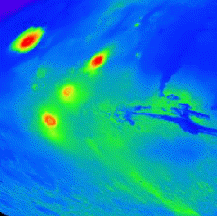This drawing shows the possible geography of Martian water.
Click on image for full size
NASA
The Transfer of Water in Martian History
On Mars, the water is trapped, frozen, within the ground. Nevertheless, there is evidence for running water on Mars.
When the water is melted and released to the surface, it will run from higher ground to lower ground.
Because this water transfer can only take place when the water melts, however, the water transfer takes a very long time.
You might also be interested in:

The drawing shows the depth at which water may be frozen into the ground. To have water running on the surface of Mars, this water region must be near to the surface. This may have happened at various
...more
On this map of Mars, the lightly cratered Tharsis Ridge is shown, as well as the heavily cratered Martian highlands (near the bottom of the picture), and Valles Marineris to the right. The volcanoes are
...more
On Mars, the water is trapped, frozen, within the ground. Nevertheless, there is evidence for running water on Mars. When the water is melted and released to the surface, it will run from higher ground
...more
Separate from the Martian outflow channels, or the river valleys, are large Martian lakes (600 km, or ~1000 miles across) which once were part of a flood.
...more
This picture shows fog on Mars. More fog has been seen in images returned by Mars Global Surveyor of the south polar region of Mars. Martian fog may have a little bit of acid mixed in with the water drops.
...more
The orbit of Mars is very oval shaped. The orbit is much more oval shaped than the Earth's orbit. This means that the climate of Mars can change drastically between warm and cold.
...more
This is an image of a storm moving across the Martian land. The camera is looking down on the storm, the same way storms are presented on the news. The storm provides evidence that there is water on Mars.
...more
This is image of a Martian sunset illustrates just how thin the Martian atmosphere is. In this image, the Martian sky appears pink and a little bit dark at sunset. Unlike the Martian sky, the Earth's sky
...more













